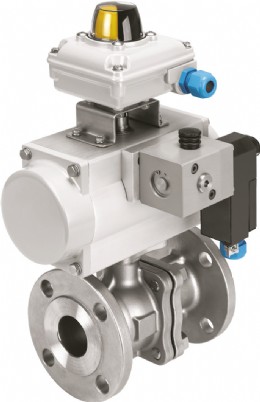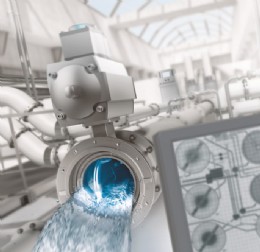Simple ways to save costs when selecting process valves for your application

Kai Feller


What media do you want to control?
The best place to start is with the media to be controlled, because it will affect the options available for the material of the valve. After the selection of the right type of valve the correct construction material has to be determined. If the media is aggressive or corrosive, then stainless steel is likely to be the best option. However, for many common applications – supply of cooling water in a machine for example – a brass ball valve or butterfly valve with polyamide coated discs are perfectly adequate. They also cost far less than the stainless steel alternatives. By making smart choices, it is possible to deliver both best quality and best price when selecting valves.
What operating pressure are you working with?
The choice of operating pressure can have significant cost and energy implications. All valves are clearly pressure rated and there is a wide selection available. For butterfly valves, PN16 is the most common nominal rating specified for general industrial applications – but this does not mean it is the most efficient for your specific requirements. For example, if the process pump supplying the media will only ever deliver at 4 bar, or if the valve is mounted on the outlet of an open vessel, there is an opportunity to select lower media pressure ratings on the valve. Festo supplies its butterfly valves with different undercut discs which can lower the actuation torque if the maximum media pressure is lowered. The connection norm and the burst pressure rating of the valve remain unchanged. In turn, a lower pressure rated disc leads to a smaller, lower cost actuator.
What actuator technology is best?
Actuators come in four basic types: manual, electric, hydraulic or pneumatic. The final selection will be influenced by the number of valves you want to control and whether functions like a failsafe option or adjustable speed are necessary. Air actuators are quite simple in design compared to electric actuators, so they offer lower initial and servicing costs. Pneumatic actuators can be very cost-effective for applications where more than three or four valves are involved – even where no dedicated compressed air supply is available. The pneumatic solution generally offers good feature selection and good value. Festo has developed tools to help its customers make lifecycle cost comparisons between electrical and pneumatic actuators.
What safety functions are needed?
A double-acting pneumatic actuator fulfils basic safety requirements in most applications because it will stop in its current position if the compressed air supply is lost. It’s actually the less expensive option because it requires fewer internal parts and can be smaller in size, providing a cost optimised alternative to a single-acting actuator. For safety-critical operations, such as the transportation of flammable gas or liquids that present a contamination danger, a single actuator provides enhanced safety.
What should the actuator be made of?
Just as the process media will affect the materials specification for the valve itself, the environmental conditions in which the actuator is expected to operate will influence final selection. Don’t just think about the immediate working environment; consider nearby chemical dosing and cleaning regimes too. There is little point in paying a premium for stainless steel actuators if they are not necessary. If a standard aluminium actuator is not suitable, epoxy-coated actuators are cost-competitive and resistant to most chemicals (although they are not suitable for applications where they will be fully submerged). Our DFPD actuators can be ordered with coating options as well as different shaft materials, so Festo customers only pay for what they need.
Have you optimised the actuator selection according to your air network pressure?
Ascertaining the compressed air network pressure is critical to optimising the sizing of pneumatic actuators. Industrial applications commonly use 5.5 or 6 bar systems as they are believed to be the most economical in general terms. However, where higher pressure is supplied a smaller actuator can be specified, which means a lower purchasing cost and a reduction in energy wastage. If the plant is running on a lower pressure a larger size actuator is required to ensure that safety factors are not compromised. In some circumstances it can be more cost-effective to install a local pressure booster to supply air to the actuator, rather than running the entire system to deliver at the actuator’s pressure rating. Our downloadable Process Valve Automation Tool helps customers to select the right actuator and valve combination for each given pressure across a range of suppliers and manufacturers. www.festo.co.uk/paa
What are the options for achieving greater control?
Some processes require precise control of fluids and gases, where a simple on/off function is not enough. We therefore need to consider modulating options. The market offers many electro-pneumatic positioners with numerous features which are capable of operating in the toughest environments as standard. However, ATEX compliance comes at a price. If your operation is not subject to extreme conditions then a cost effective alternative might be the CMSX from Festo, which has all the core control functionality without the Ex rating and fieldbus functions that more expensive positioners include. If the application is even simpler, then a 5/3 control valve with analogue sensor box is an adequate and low cost option.
What is cheaper: Namur mounted single solenoid valves or valve terminals?
A valve terminal can supply multiple process valves and has fieldbus and communications connectivity built in. Specifying valve terminals reduces wiring requirements. In addition, valve terminals give visual status confirmation, diagnostics and functions like manual override at a convenient location which make commissioning and maintenance much easier because the controls are readily accessible. All these advantages sound expensive, but basic valve terminals can be very cost effective depending on the number of valves to be controlled. Savings can be even more significant once cost for installation, wiring, loop-checks and startup or even maintenance are taken into account. We have consultants who evaluate these options daily and are on hand to help specifiers make the best choice.
Are pneumatics and slow process valve movements compatible?
Using blasts of air can initiate very quick changes to the state of equipment and this is not something that is always welcome in process control. Controlling the air flow to regulate speed and smoothness of operation is therefore important. Flow control valves can throttle the flow in and out of the actuator. Where the reduction in flow of the inlet air might lead to slip stick effect, the throttling of the outlet air can cause unwelcome side-effects. For instance, where single-acting actuators are used with a state-of-the-art Namur mounted solenoid valve the rebreather function will essentially make the valve faster. The main purpose of the rebreather function is to supply the spring chamber with clean process air instead of dusty and humid environmental air, reducing wear and corrosion. The correct way slow down the speed of these valves is a flow control plate, which is available with one way or two way control.
Any other considerations?
Lubrication of moving parts is necessary to make sure that the pneumatic valves and actuators continue to give optimum performance. Traditionally this has entailed an ongoing maintenance requirement to check and top up lubricating oils; which not only has lifetime cost implications but also some environmental issues associated with it. Modern pneumatic systems for industrial applications now feature lifetime lubricants to offer trouble-free operation throughout their design life. The only challenge is to remember not to introduce any oils at all!
Tel: 01252 775000
Email: info_gb@festo.com
Web: www.festo.com/gb

| Telephone: | 0800 626422 |
| Email: | info.gb@festo.com |
| Website: | www.festo.com |
| More information on the Festo Ltd BVAA Member Directory Page |
Search related valve / actuator articles: Festo LtdIssue 42Master Class











